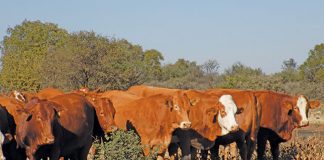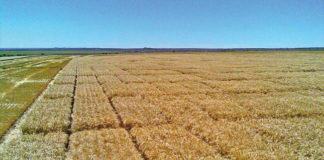
Grain SA scientist Hendrik Smith recently reposted a table showing that ‘grass-fed’ beef has more positive properties than ‘grain-fed’ beef.
To his credit, he afterwards posted a statement by Dr Heinz Meissner that refuted most of the claims. Unfortunately, as so often in the past, the initial post claimed that intensive beef farming was bad for the environment and the consumer.
It has to be remembered that grass-fed beef cattle also consume grain, and grain-fed beef consume grass and other roughage.
Calves are weaned on natural pastures, sold to feedlots and fed for four months before slaughter. Cows on pasture receive additional feed to enable them to survive and provide milk for their calves.
This consists of maize meal, sugar by-products, salt, phosphate, microelements and vitamins, amongst others.
Feedlot operators feed rations based on maize meal, sugar by-products, other grains and oilseeds, grain milling by-products, phosphates, microelements, vitamins and other ingredients, combined with roughage such as silage and other grasses.
There is very little difference between the systems, and one can describe both as grass- and grain-fed.
Antibiotics and hormones
The misuse of antibiotics has resulted in the build-up of serious resistance to this type of medication worldwide. The national Department of Health reports that humans consume 74% of all antibiotics; the rest goes to animals.
The department of agriculture’s residue-monitoring programme detected antibiotic residue in 2% of samples tested, with beef accounting for half of the positive samples.
About 62% of all antibiotics used in agriculture are growth promoters. Farmers and feedlots also use antibiotics to treat sick animals.
Tetracycline antibiotics are available without a prescription. Farmers and feedlots generally adhere to the withdrawal periods for antibiotics, which is why the incidence of residues in samples is very low.
All livestock farmers need to use antibiotics correctly and only when needed. There is no difference in the levels of antibiotic residue in intensive and extensive beef.
Both plants and animals contain hormones. Beef from cattle implanted with growth hormones contains 0,007 micrograms (μg) of hormones per 500g. In non-implanted cattle, the figure may be slightly lower at 0,005μg.
The difference is insignificant. Hormone levels in many other food products are higher than in beef. Soya bean oil, for example, contains 1 000μg/500g.
The ‘hormone issue’ is actually a non-issue. Retail chains use labels such as hormone-free to gain competitive advantage.
Environmental concerns
In 2006, the Food and Agricultural Organization of the United Nations concluded that it was essential to continue intensifying livestock production to improve environmental and economic sustainability.
Various studies show that greenhouse gas emissions per unit of beef are higher in pasture-based systems than feedlots.
Well- known sustainability expert Jude Capper calculated that converting to grass-fed beef production in the US would increase carbon emissions by the same amount as the addition of 26 million cars on the road.
In South Africa, more than 75% of cattle slaughtered are finished in feedlots. It would be impossible to produce enough beef in extensive systems, and the carbon footprint of the extensive beef production system can only be lowered through intensifying the system.
In addition, feedlots are large users of other food production by-products such as soya bean and cotton oilcake, ensuring that these do not end up in landfill sites.
To sum up, there is a place for both systems. Be warned, though; advertising that lists some of the alleged negative aspects of the predominant beef production system in South Africa will have an adverse effect on both extensive and intensive producers.











